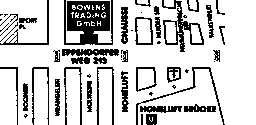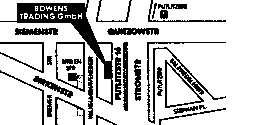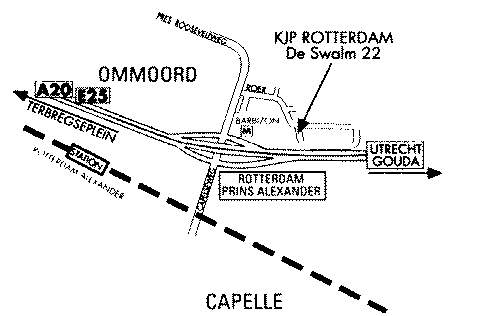 Bowens GmbH, Hamburg,
location map and view, below
Bowens GmbH, Hamburg,
location map and view, belowThe establishment of KJP outlets throughout in Europe should not be seen as merely allowing UK photographers working abroad to find a little bit of England where they can feel safer about buying supplies. The truth of the matter is very much more positive, with KJP having made the decision not to establish 'British outposts' but to build a pan-European network of outlets, all serving their local markets.
"Even before the single market, it wasn't that difficult to trade throughout Europe," explains KJP European Sales Director Francis Newman ([email protected]). "It's attitudes that have changed." In KJP's case, this attitude can be traced back to former MD Jon Whiting, who Newman describes as "a great European". When interviewed in 1991, Whiting compared the countries of Europe to the states of the USA, declaring his intention to have "one distributor for the whole of Europe, not different distributors for individual countries".
With branches already opened in Amsterdam and Hamburg, KJP was even then the biggest European customer for both Kodak and Polaroid materials, buying the former's products in whichever country offered the best price. Neither Kodak nor Fuji had harmonised their European prices, though Polaroid, Hasselblad and Sinar all had. Interestingly, and despite its canny buying policy, KJP was another of the companies that chose not to harmonise its prices.
KJP's first mainland-Europe outlet opened in Amsterdam in 1989 and was a roaring success from the word go. Housed in an industrial unit on the outskirts of the city, the branch is now something of a meeting point for photographers working in and around the Dutch capital. It is well placed, close to both motorways and Schiphol airport, and offers plenty of car parking. The huge warehouse storage area is also the main distribution centre for products going to all the European countries.
 Bowens GmbH, Hamburg,
location map and view, below
Bowens GmbH, Hamburg,
location map and view, below

In 1990, Bowens GmbH, in Hamburg, became part of the KJP Group. This move
marked a return to the fold for the German company, which had been
purchased by Staffen & Hurtig Fotoservice from KJP parent company
Promandis in 1984. Since that time, Bowens's profile in Germany had
increased steadily, building on Staffen & Hurtig's success since its own
founding some 20 years previous. As well as being a retail outlet, Bowens
GmbH now acts as a small-scale design and production facility for items
that cannot be produced economically at the main Bowens factory in England.
 KJP Berlin location
map, left
KJP Berlin location
map, left
KJP Dresden location map, below

Francis Newman admits that the
first of these was partly a reaction to the events of that time. "With the
fall of the Berlin Wall, a lot of photographers went there for emotional
reasons, then they were gone again in six months." Car parking was also a
problem, and without good access business was bound to be affected.
Dresden, in the east of the city, had a similarly shaky start, though now
there are rental, repair and processing facilities installed as well as
equipment and consumables sales. As Newman explains, "it takes time to
build up branches, to build up a good range of services".
 The association between retail and processing services is one that makes
sound practical sense, especially in areas where photographic facilities
are either fewer in number or more widely spread. After access routes and
parking, Newman puts proximity to processing facilities third on the list
of desirable attributes for any KJP branch. So it is that when searching
Holland for a second site on which to open, KJP chose one in Rotterdam
that was situated very close to a major lab.
The association between retail and processing services is one that makes
sound practical sense, especially in areas where photographic facilities
are either fewer in number or more widely spread. After access routes and
parking, Newman puts proximity to processing facilities third on the list
of desirable attributes for any KJP branch. So it is that when searching
Holland for a second site on which to open, KJP chose one in Rotterdam
that was situated very close to a major lab.
KJP Rotterdam showroom, right; location map, below

The same association also applies here in the UK, with London's Ramillies Street branch sharing a building with Sky Photographic Services, for example.
But there is more to successful retailing than selling alone. "In any location, if we want people to come to us we have to give something back, whether it's service clinics, seminars or letting trade associations use our premises. We'll do all that wherever we are."
In terms of equipment offered, Amsterdam's rental list has Canon 35mm kit but not Nikon, and Pentax 6 x 7 but not Mamiya. Hamburg lists just the F90 and Nikkor AF 300mm f2.8 under its 35mm equipment, and adds Rollei to its medium format list. Hasselblad is everywhere, as is Bowens lighting. "London," Newman says, "is completely untypical: rental is so cheap, probably because there's so much going through here." At current basic day-rates, a 500CM body costs 30Gld (about $17) in Amsterdam, 25Dm (about $16) in Hamburg, and �6 ($10) in London.
"Every year we think that we understand the different countries, but we don't. The culture thing is still something you have to be aware of. I'm quite interested in how they see us." The answer to this could well be in the same vein as our own image of the French lying somewhere between Jean Paul Gaultier and Antoine de Caunes. A cross between Vivienne Westwood and the Queen Mother perhaps?
As to future plans, a strong emphasis is currently being placed on providing a true pan-European service. One idea being investigated is a billing system whereby photographers working abroad can have purchases and rentals charged to their home accounts. Another service, which is already in place, is assistance with studio hire. Newman is pleased to announce that the Amsterdam branch, in particular, arranges such facilities on a regular basis, and that even the KJP Head Office in Milton Keynes, UK, can provide information about working abroad.
"We get calls from photographers going abroad asking where they can get background paper or whatever, and we're happy to help. Without blowing our own trumpet too much, we're an international company and we know a lot of people."
"Following our 1994 acquisition of Calumet, I might be seeing the same photographer in our New York or Los Angeles showrooms". Whether through its agents or in person, wherever UK photographers work, KJP intends to be there.